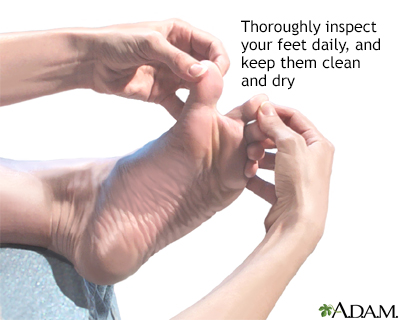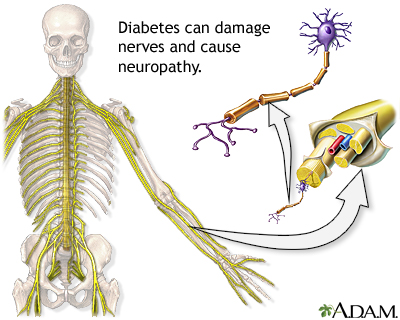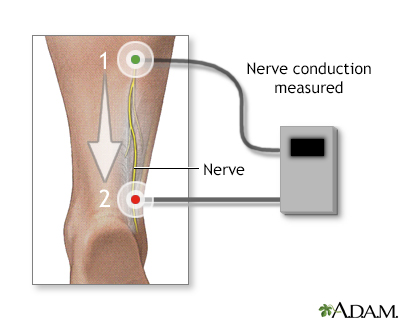Charcot foot
Charcot foot is a condition that affects the bones, joints, and soft tissue in the feet and ankles. It can develop as a result of nerve damage in the feet due to diabetes or other nerve injuries.
Diabetes
Diabetes is a long-term (chronic) disease in which the body cannot regulate the amount of sugar in the blood.

Causes
Charcot foot is a rare and disabling disorder. It is a result of nerve damage to the feet. A common cause is peripheral neuropathy.
Peripheral neuropathy
Peripheral nerves carry information to and from the brain. They also carry signals in both directions between the spinal cord and the rest of the bo...

Diabetes is the most common cause of this type of nerve damage. This damage is more common in people with type 1 diabetes. When blood sugar levels are high over a long time, both nerve and blood vessel damage occurs in the arms and legs.
Type 1 diabetes
Type 1 diabetes is a lifelong (chronic) disease in which there is a high level of sugar (glucose) in the blood.

Blood sugar levels
A blood sugar test measures the amount of sugar (glucose) in a sample of your blood. Glucose is a major source of energy for most cells of the body, ...

Diabetes - Animation
Diabetes is on the rise worldwide, and is a serious, lifelong disease that can lead to heart disease, stroke, and lasting nerve, eye and foot problems. Let's talk about diabetes and the difference between the three types of diabetes. So, what exactly is diabetes and where does it come from? An organ in your body called the pancreas produces insulin, a hormone that controls the levels of your blood sugar. When you have too little insulin in your body, or when insulin doesn't work right in your body, you can have diabetes, the condition where you have abnormally high glucose or sugar levels in your blood. Normally when you eat food, glucose enters your bloodstream. Glucose is your body's source of fuel. Your pancreas makes insulin to move glucose from your bloodstream into muscle, fat, and liver cells, where your body turns it into energy. People with diabetes have too much blood sugar because their body cannot move glucose into fat, liver, and muscle cells to be changed into and stored for energy. There are three major types of diabetes. Type 1 diabetes happens when the body makes little or no insulin. It usually is diagnosed in children, teens, or young adults. But about 80% of people with diabetes have what's called Type 2 diabetes. This disease often occurs in middle adulthood, but young adults, teens, and now even children are now being diagnosed with it linked to high obesity rates. In Type 2 diabetes, your fat, liver, and muscle cells do not respond to insulin appropriately. Another type of diabetes is called gestational diabetes. It's when high blood sugar develops during pregnancy in a woman who had not had diabetes beforehand. Gestational diabetes usually goes away after the baby is born. But, still pay attention. These women are at a higher risk of type 2 diabetes over the next 5 years without a change in lifestyle. If you doctor suspects you have diabetes, you will probably have a hemoglobin A1c test. This is an average of your blood sugar levels over 3 months. You have pre-diabetes if your A1c is 5.7% to 6.4%. Anything at 6.5% or higher indicates you have diabetes. Type 2 diabetes is a wake up call to focus on diet and exercise to try to control your blood sugar and prevent problems. If you do not control your blood sugar, you could develop eye problems, have problems with sores and infections in your feet, have high blood pressure and cholesterol problems, and have kidney, heart, and problems with other essential organs. People with Type 1 diabetes need to take insulin every day, usually injected under the skin using a needle. Some people may be able to use a pump that delivers insulin to their body all the time. People with Type 2 diabetes may be able to manage their blood sugar through diet and exercise. But if not, they will need to take one or more drugs to lower their blood sugar levels. The good news is, people with any type of diabetes, who maintain good control over their blood sugar, cholesterol, and blood pressure, have a lower risk of kidney disease, eye disease, nervous system problems, heart attack, and stroke, and can live, a long and healthy life.
Nerve damage makes it harder to notice the amount of pressure or pain on the foot or if it is being stressed. The result is ongoing small injuries to the bones and ligaments that support the foot.
- You may develop bone stress fractures in your feet, yet never know it.
- Continuing to walk on the fractured bone often leads to further bone and joint damage.
Other factors leading to foot damage include:
- Blood vessel damage from diabetes can increase or change blood flow to the feet. This can lead to bone loss. Weakened bones in the feet increase the risk of fracture.
- Injury to the foot signals the body to produce more inflammation-causing chemicals. This contributes to swelling and bone loss.
Symptoms
Early foot symptoms may include:
- Mild pain and discomfort
- Redness
- Swelling
- Warmth in the affected foot (noticeably warmer than the other foot)
At later stages, bones in the foot break and move out of place, causing the foot or ankle to become deformed.
- A classic sign of Charcot is rocker-bottom foot. This occurs when the bones in middle of the foot collapse. This causes the arch of the foot to collapse and bow downward.
- The toes may curl downward.
Bones that stick out at odd angles can lead to pressure sores and foot ulcers.
Foot ulcers
If you have diabetes, you have an increased chance of developing foot sores, or ulcers, also called diabetic ulcers. Foot ulcers are a common reason ...

- Because the feet are numb, these sores and ulcers may grow wider or deeper before they are noticed.
- High blood sugar also makes it hard for the body to fight infection. As a result, these foot ulcers may become infected.
Exams and Tests
Charcot foot is often difficult to diagnose early on. It can be mistaken for sprains, bone infection, arthritis or joint swelling. Your health care provider will take your medical history and examine your foot and ankle.
Blood tests and other lab work may be done to help check for other causes.
Your provider may check for nerve damage with these tests:
- Electromyography
Electromyography
Electromyography (EMG) is a test that checks the health of the muscles and the nerves that control the muscles.
 ImageRead Article Now Book Mark Article
ImageRead Article Now Book Mark Article - Nerve conduction velocity tests
Nerve conduction velocity tests
Nerve conduction velocity (NCV) is a test to see how fast electrical signals move through a nerve. This test is done along with electromyography (EM...
 ImageRead Article Now Book Mark Article
ImageRead Article Now Book Mark Article - Nerve biopsy
Nerve biopsy
A nerve biopsy is the removal of a small piece of a nerve for examination.
 ImageRead Article Now Book Mark Article
ImageRead Article Now Book Mark Article
The following tests may be done to check for bone and joint damage:
-
Foot x-rays
x-rays
X-rays are a type of electromagnetic radiation, just like visible light. An x-ray machine sends individual x-ray waves through the body. The images...
 ImageRead Article Now Book Mark Article
ImageRead Article Now Book Mark Article - Foot MRI
Foot MRI
A leg MRI (magnetic resonance imaging) scan of the leg uses strong magnets to create pictures of the leg. This may include the ankle, foot, and surr...
 ImageRead Article Now Book Mark Article
ImageRead Article Now Book Mark Article - Bone scan
Bone scan
A bone scan is an imaging test used to diagnose bone diseases and find out how severe they are.
 ImageRead Article Now Book Mark Article
ImageRead Article Now Book Mark Article
Foot x-rays may look normal at early stages of the condition. Diagnosis often comes down to recognizing early symptoms of Charcot foot: swelling, redness, and warmth of the affected foot.
Treatment
The goal of treatment is to stop bone loss, allow bones to heal, and prevent bones from moving out of place (deformity).
Immobilization -- Your provider will have you wear a total contact cast. This will help limit movement of your foot and ankle. You will likely be asked to keep your weight off your foot entirely, so you will need to use crutches, a knee-walker device, or wheelchair.
You will have new casts placed on your foot as the swelling comes down. Healing can take a couple of months or more.
Protective footwear -- Once your foot has healed, your provider may suggest footwear to help support your foot and prevent re-injury. These may include:
- Splints
- Braces
- Orthotic insoles
- Charcot restraint orthotic walker, a special boot that provides even pressure to the whole foot
Activity changes -- You will always be at risk for Charcot foot coming back or developing in your other foot. So your provider may recommend activity changes, such as limiting your standing or walking, to protect your feet. You may need to use a wheelchair to limit activity on your feet.
Surgery -- You may need surgery if you have foot ulcers that keep coming back or severe foot or ankle deformity. Surgery can help stabilize your foot and ankle joints and remove bony areas to prevent foot ulcers.
Ongoing monitoring -- You will need to see your provider for checkups and take steps to protect your feet for the rest of your life.
Outlook (Prognosis)
The prognosis depends on the severity of foot deformity and how well you heal without infection. Many people do well with braces, activity changes, and ongoing monitoring.
Possible Complications
Severe deformity of the foot increases the risk of foot ulcers. If ulcers or the underlying bone becomes infected and hard to treat, it may require amputation.
Amputation
Leg or foot amputation is the removal of a leg, foot or toes from the body. These body parts are called extremities. Amputations are done either by...
Read Article Now Book Mark ArticleWhen to Contact a Medical Professional
Contact your provider if you have diabetes and your foot is warm, red, or swollen.
Prevention
Healthy habits can help prevent or delay Charcot foot:
- Keep good control of your blood glucose levels to help prevent or delay Charcot foot. But it can still occur, even in people with good diabetes control.
- Take care of your feet. Check them every day.
Take care of your feet
Diabetes can damage the nerves and blood vessels in your feet. This damage can cause numbness and reduce feeling in your feet. As a result, your fe...
 ImageRead Article Now Book Mark Article
ImageRead Article Now Book Mark Article - See your foot doctor regularly.
- Check your feet regularly to look for cuts, redness and sores.
- Avoid injuring your feet.
Reviewed By
C. Benjamin Ma, MD, Professor, Chief, Sports Medicine and Shoulder Service, UCSF Department of Orthopaedic Surgery, San Francisco, CA. Also reviewed by David C. Dugdale, MD, Medical Director, Brenda Conaway, Editorial Director, and the A.D.A.M. Editorial team.
American Diabetes Association Professional Practice Committee. 12. Retinopathy, Neuropathy, and Foot Care: Standards of Care in Diabetes-2025. Diabetes Care. 2025;48(Suppl 1):S252-S265. PMID: 39651973 pubmed.ncbi.nlm.nih.gov/39651973/.
Baxi O, Yeranosian M, Lin A, Munoz M, Lin S. Orthotic management of neuropathic and dysvascular feet. In: Webster JB, Murphy DP, eds. Atlas of Orthoses and Assistive Devices. 5th ed. Philadelphia, PA: Elsevier; 2019:chap 26.
Brownlee M, Aiello LP, Sun JK, et al. Complications of diabetes mellitus. In: Melmed S, Auchus RJ, Goldfine AB, Rosen CJ, Kopp PA, et al, eds. Williams Textbook of Endocrinology. 15th ed. Philadelphia, PA: Elsevier; 2025:chap 38.




 All rights reserved.
All rights reserved.